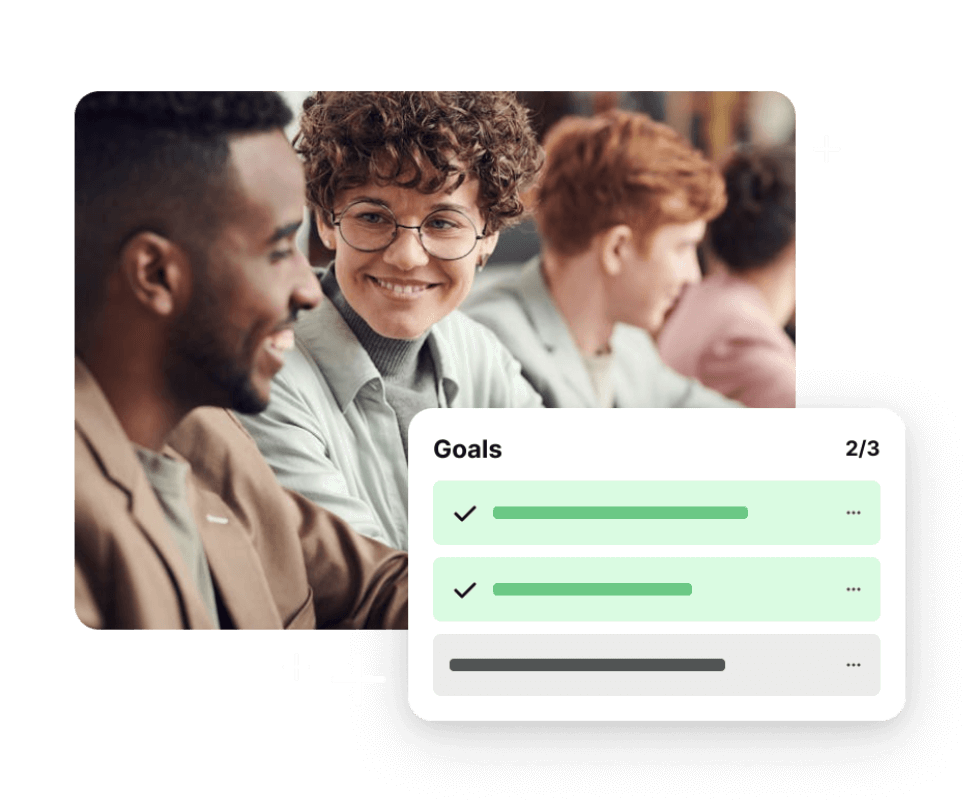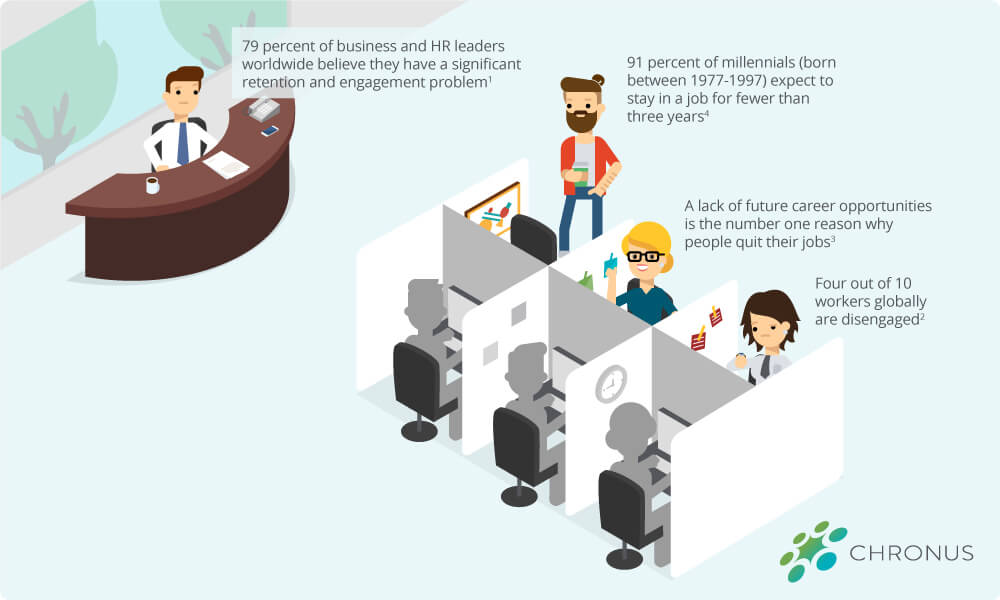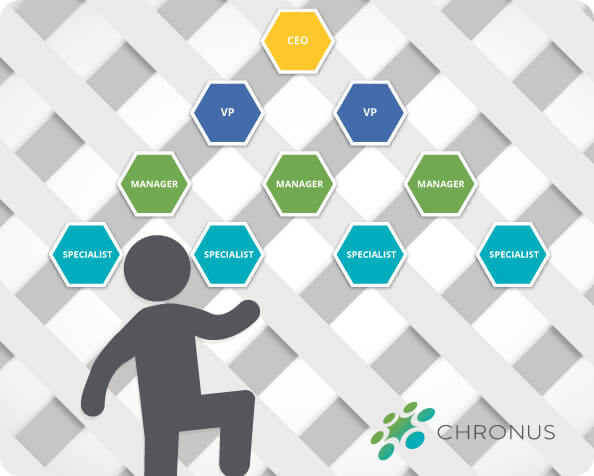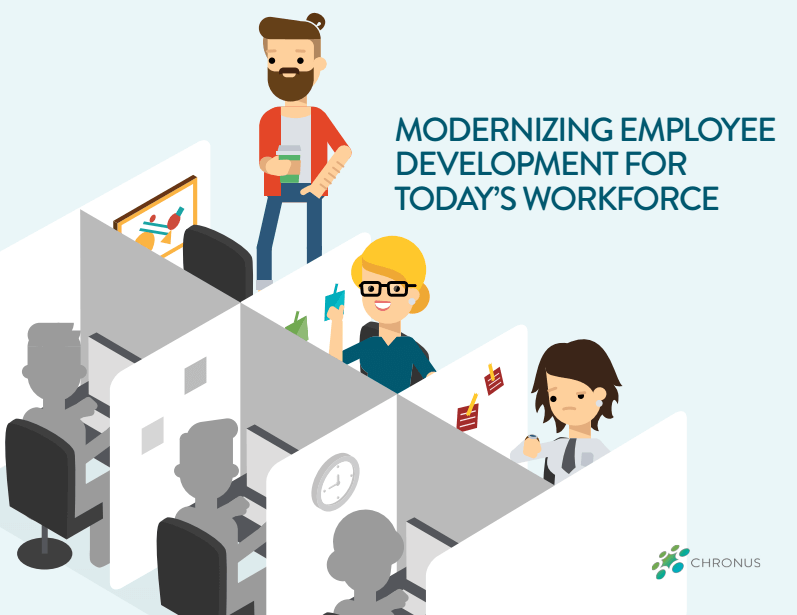Employee Development for Today’s Workforce

What is Employee Development?
Employee development is a process in which employees improve their knowledge, skills and career prospects with the support of their employer. This can be achieved through professional training and skill development opportunities, mentoring, job shadowing, stretch assignments, employee upskilling and more. Employee development goes beyond acquiring skills for current roles to help employees move forward on their individual career path.
Download Modernizing Employee Development For Today’s Workforce

Why is Employee Development Important?
Today’s hybrid workplace is a fast-paced, competitive environment, and people are seeking a new kind of employee development to meet their personal and professional needs. In light of the Great Resignation/Reshuffle and trends of ‘quiet quitting’ companies can’t remain passive about employee development programs. Employee development and the cost of losing talent is too high. On average, every lost employee costs about six to nine months of that employees’ salary to replace. And that doesn’t count the indirect costs of lost productivity.
Career Growth
As the Great Reshuffle has clearly shown, employees are taking their careers into their own hands, choosing to leave positions where they are not valued or they don’t feel they have a future. Employee development offers workers the means to grow in their careers rather than feeling stuck. Offering employees training programs that grow their skills and experience not only helps workers; it helps employers cultivate a skilled workforce who can contribute more to the company — and who have the career growth and interest they need to stay.
Employee Retention
Employees consistently cite career development as critical to their satisfaction with an organization, and the lack of it is a key reason why they change jobs. According to the Conference Board, 96% of employees surveyed say it is important for them to continuously develop their work-related skills, and 58% say they are likely to leave their company without professional development.That percentage is even higher for women, people of color, and Millennials. According to a Paychex report, 63% of employees surveys said they would be more likely to stay at their current employer if they had better access to these career development opportunities.
Employee Potential and Performance
If workers don’t have opportunities to learn and grow, it’s harder for them to reach their full potential. In fact, 74 percent of employees say that they aren’t able to reach their full potential due to a lack of professional development, according to research from ClearCompany.
This is a missed opportunity for both employees and employers. For workers, a lack of development often results in boredom and a feeling of stasis, which can lead to them searching for greener pastures. On the company side, having employees who aren’t reaching their potential can also mean they aren’t performing up to par. Employees who are learning and growing are also going to be offering higher levels of performance as they close their skills gap.
Increased Productivity and Engagement
Career development is key to employee engagement, keeping employees learning, growing and on the right track to their career aspirations. That engagement is crucial to keeping employees interested in their jobs and motivated to do their very best work. According to research from Gallup, companies with a highly engaged workforce tend to have higher productivity as well as profitability. Focused development also improves competency of employees in their current and future roles, and it increases their loyalty to the organization.
Profitability
Research shows companies that offer comprehensive training have a 24 percent higher profit margin and 218 percent higher income per employee than companies that don’t. It makes sense: Employees who are developing their skills and knowledge are more likely to be invested in their current jobs and future prospects. That means they are more likely to care about outcomes for the company and put their knowledge and skills to work in achieving the organization’s goals.
Employee Satisfaction
When an organization invests in employee development, it contributes to higher job satisfaction in several ways. Just the fact that the company offers these opportunities helps employees know they are valued by the company enough to invest in. Workers who take advantage of development programs build their capabilities, confidence and levels of success. And employees who participate in development are more likely to have a clear, reachable career path ahead, contributing greatly to job satisfaction.
What Does Modern Employee Development Look Like?
Modern employee development programs should be structured in a way to offer fair and inclusive opportunities for all employees. This means processes and programs should be formalized and transparent, while being easy for employees to understand and access. These programs should also be scalable across the organization—which means minimizing the manual work that HR professionals have to do to keep these programs running and effective.
Building the The Career Lattice

Providing your employees with more ways to move laterally and rewarding them for it encourages them to:
- Learn and grow without feeling stymied
- Advance their own knowledge and careers
- Assume greater ownership for their own career growth
It’s a mutually beneficial situation: your company will benefit from employees with broad organizational knowledge and those employees will gain opportunities to explore other paths that increase their skillsets.
However, career lattices don’t often happen spontaneously. Both employees and managers need to understand that gaining additional skills, expanding cross-functional knowledge and participating in lateral moves are all important building blocks for the future – and they need a little help implementing it as part of an employee development plan or upskilling program.
Spanning the Employee Lifecycle
Whether the employee in question is a younger millennial, a high potential, or an employee who wishes to deepen subject matter expertise, career development opportunities are valuable. So what should employee development plans look like across the employee lifecycle? Here are some examples:
Onboarding buddy program
Jonathan Jones is a new sales employee with limited knowledge of the product. His company’s onboarding program provides him with a unique training plan and a buddy to help him develop nuanced industry knowledge faster.
Career mentoring
Kim Chen aspires to be a controller one day. Her manager helps her develop a solid plan that puts her on track to gain needed skills by meeting the right people through a mentoring program.
Employee Upskilling Program
Similar to an employee development program, employee upskilling is designed to keep your organization agile in the face of industry and technological changes. Reskilling or upskilling your employees helps them grow their skill set while also creating a culture of learning, setting your company apart from others in your industry. There are many benefits to employee upskilling, such as increased employee retention and cost savings to your organization.
Leadership development/high potential
Sarah Arcangell is a promising employee who has just been promoted to manage a team. She’s still learning how to best manage herself while engaging others, so she’s matched up with other leaders in the company to learn soft skills and ensure she excels.
Diversity
Christine Lawson works in a male-dominated environment where she feels her quiet demeanor might hold her back. Her manager encourages her to join a diversity mentoring program. Christine’s matched with a female executive who passes on advice to help her feel comfortable and succeed.
Succession planning & knowledge transfer
Edward McCain is a senior engineer who’s approaching retirement. As part of the mentoring initiative to promote knowledge transfer, he’s matched with a young new hire who’s eager to learn from Edward’s expertise.
Ultimately, the key to all of these program examples is helping people gain true insight into career advice as part of executing their career plans. When it comes to career development, it’s true that employees should be self-directed and drive the process — but they still want guidance from other people in determining a career path. By combining employee development programs such as mentoring, buddy systems, and career pathing, you can provide employees with what they want while driving significant business results for your company.
Get the eBook Now
Download the Free eBook to Take on the Go

How to Create an Employee Development Plan
Here’s a high-level overview of what the employee development planning should look like:
- Organizations should think about the skills they must cultivate in their people to hit target growth objectives
- Employees should consider skills that are important to their own current and future goals
- Managers must help employees lay out career plans through a formalized process that aligns to company goals
- Organizations need to provide employees with programs and tools to make their career development happen
This process isn’t easy. There are many needs to serve and it’s not simple to provide employees with the programs and tools that are necessary. Luckily, there are several ways to create impactful employee development programming.
Employee Development Plan Examples
An employee development plan will include long-term goals, short-term goals, actions needed to reach these goals (including timelines), and how progress will be measured.
Each plan needs to be highly personalized, based on the employee’s strengths, professional goals, and development needs. It’s crucial to conduct in-depth discussions with workers that address all these elements before creating their plans.
These examples of career development plans can give you an idea of how they can be crafted.
Example 1:
- Long-term goal: Promotion to manager
- Short-term goal: Develop leadership skills
Action 1: Connect with an experienced leader who can become a mentor
Target timeline: One month
Measurement: Employee began mentoring sessions
Action 2: Participate in online leadership course
Target timeline: Six months
Measurement: Employee completed course
Action 3: Lead a team project
Target timeline: One year
Measurement: Project was successfully executed under leadership of employee
Example 2:
- Long-term goal: Move from customer service to sales
- Short-term goal: Gain sales skills
Action 1: Participate in job shadowing to learn more about the day-to-day of a sales position
Target timeline: One month
Measurement: Employee completed job shadowing assignment
Action 2: Take part in internal sales training
Target timeline: Three months
Measurement: Employee completed training
Action 3: Achieve outside sales certifications
Target timeline: Six months
Measurement: Employee earned certifications
Example 3:
- Long-term goal: Become a published expert in the field
- Short-term goal: Develop writing skills
Action 1: Take an online writing course
Target timeline: One month
Measurement: Employee completed course
Action 2: Contribute to company blog
Target timeline: Six months
Measurement: Employee published a target number of blog posts
Action 3: Publish articles in outside outlets
Target timeline: One year
Measurement: Employee has published target number of articles
Implementing an Employee Development Plan
Once the employee development plan is created, it’s time to implement it.
Communicating the plan to the employee
The first step is making sure the employee understands the plan and that it’s relevant and realistic for them. The person should understand the ‘why’ and ‘how’ of the plan in order to buy-in to the journey ahead.
Providing necessary resources and support
It’s also crucial for you to make sure you offer the resources needed for the employee to successfully follow the plan. As your employee commits to following the plan in order for them to develop, your commitment to support them is key.
Monitoring progress and providing feedback
A big part of this support is having a system in place to keep track of the employee’s progress. Often, this means regular check-ins where the employee can address accomplishments and obstacles and receive feedback and guidance.
Making adjustments when necessary
Finally, you’ll need to keep adjusting the plan as necessary. The employee’s goals, interests, and circumstances may change, and their development plan should be dynamic to reflect these changes, offering an action-oriented framework that can grow with them.
Evaluating Your Employee Development Plans
A key part of making this work is by connecting employees to the right people, which often happens through mentoring, coaching, networking and sponsorship.
While creating career plans, it’s important to ensure managers include measurable outcomes to determine the financial impact of the program. For example, you can track whether employees participating in career development increase their knowledge more than those who don’t, or whether savings from reduced turnover outweigh the associated costs of the program. Your leadership will always be interested in the cost and proven outcomes of your career development programs and if you can tie a monetary value to them, those programs will be considered all the more valuable.
You should also seek employee feedback to find out how well your employee development plans are working for them and what improvements they would like to see. Make sure to inquire whether the steps are making sense to them and their plans for the future. If something is amiss, pivot and adjust the plan accordingly.
After you evaluate your plans, it’s time to make the changes that will evolve your employee development plans into the best possible tools to meet company and employee development goals. Remember, just because something is formed doesn’t mean it should never change again. Learn from experiences and feedback and adjust employee development plans to best meet the needs of your people and your company.
The Bottom Line
In today’s modern workforce, companies have to look for a new way to engage their employees. Employees want more than just to be promoted. They’re looking for continual learning and expansive opportunities to grow. So shift the focus to creating employee development plans that allow employees to drive their career development.
Do this well, and it’ll lead to happy, engaged employees who want to do their best for your company – because it means they’re doing the best for their own careers as well.
How Chronus Can Help
Technology can be a powerful tool in making employee development programs scalable and cost-effective. Chronus Software enables organizations to offer employee-driven development programs like mentoring that minimize administrative support and scale across an organization and its employee experience .
Chronus’ mentoring platform enables you to create a cloud-based program that is easy to use, complete with guided learning and goal workflows for participants. Plus, for program administrators, mentoring software includes built-in toolset to recruit, enroll, connect and guide participants, saving significant time and cost. Finally, software provides measurement tools to ensure your program provides effective learning and development that you can measure to produce real return on investment (ROI) for your program, your stakeholders and–most importantly–your people.
Mentoring Software Can Help
Watch the video to see how the Chronus mentoring platform makes it easy to start, manage, and measure modern mentorship programs.
